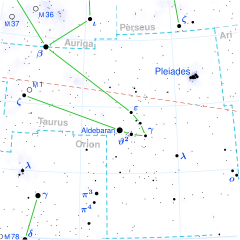
| |
| Observation data Epoch J2000.0 Equinox J2000.0 | |
|---|---|
| Constellation | Taurus |
| Right ascension | 03 24 48.79832 |
| Declination | +09° 01′ 43.9306″ |
| Apparent magnitude (V) | 3.61 |
| Characteristics | |
| Spectral type | G6 III |
| B−V color index | +0.887±0.019 |
| Astrometry | |
| Radial velocity (Rv) | −19.79±0.06 km/s |
| Proper motion (μ) | RA: −67.04 mas/yr Dec.: −78.04 mas/yr |
| Parallax (π) | 12.11 ± 0.87 mas |
| Distance | 270 ± 20 ly (83 ± 6 pc) |
| Absolute magnitude (MV) | −1.23 |
| Orbit | |
| Period (P) | 1654.9 d |
| Eccentricity (e) | 0.26 |
| Periastron epoch (T) | 2429974.34 JD |
| Argument of periastron (ω) (secondary) | 155.6° |
| Semi-amplitude (K1) (primary) | 4.4 km/s |
| Details | |
| ο Tauri A | |
| Mass | 3.21±0.12 M☉ |
| Radius | 20.28±3.66 R☉ |
| Luminosity | 302 L☉ |
| Surface gravity (log g) | 2.43±0.06 cgs |
| Temperature | 5,094±15 K |
| Metallicity | −0.13±0.02 dex |
| Rotational velocity (v sin i) | 3.29±0.61 km/s |
| Age | 324+39 −35 Myr |
| Other designations | |
| ο Tau, 1 Tauri, BD+08° 511, FK5 121, HD 21120, HIP 15900, HR 1030, SAO 111172 | |
| Database references | |
| SIMBAD | data |
ο Tauri, Latinized as Omicron Tauri, is a binary star system in the constellation Taurus, near the constellation border with Cetus. It has a yellow hue and is visible to the naked eye with an apparent visual magnitude of 3.61. It is approximately 270 light years from the Sun based on parallax, but is drifting closer with a radial velocity of −20 km/s. As the westernmost bright point of light in Taurus, this system has the Flamsteed designation 1 Tauri; Omicron Tauri is the Bayer designation.
This is a single-lined spectroscopic binary system with the two components orbiting each other over a period of 4.53 years with an eccentricity of 0.263. The visible component is an aging G-type giant with a stellar classification of G6 III. This star has three times the mass of the Sun and 20–18 times the Sun's radius. Based on the latter, interferometry-measured radius, it is rotating once every 533 days. It is radiating 302 times the luminosity of the Sun from its photosphere at an effective temperature of 5,094 K.
References
- ^ "omi Tau". SIMBAD. Centre de données astronomiques de Strasbourg. Retrieved 2019-10-10.
- ^ Anderson, E.; Francis, Ch. (2012), "XHIP: An extended hipparcos compilation", Astronomy Letters, 38 (5): 331, arXiv:1108.4971, Bibcode:2012AstL...38..331A, doi:10.1134/S1063773712050015, S2CID 119257644.
- ^ Keenan, Philip C.; McNeil, Raymond C. (1989), "The Perkins catalog of revised MK types for the cooler stars", Astrophysical Journal Supplement Series, 71: 245, Bibcode:1989ApJS...71..245K, doi:10.1086/191373.
- ^ Brown, A. G. A.; et al. (Gaia collaboration) (August 2018). "Gaia Data Release 2: Summary of the contents and survey properties". Astronomy & Astrophysics. 616. A1. arXiv:1804.09365. Bibcode:2018A&A...616A...1G. doi:10.1051/0004-6361/201833051. Gaia DR2 record for this source at VizieR.
- ^ Van Leeuwen, F. (2007). "Validation of the new Hipparcos reduction". Astronomy and Astrophysics. 474 (2): 653–664. arXiv:0708.1752. Bibcode:2007A&A...474..653V. doi:10.1051/0004-6361:20078357. S2CID 18759600. Omicron Tauri's database entry at VizieR.
- ^ Deka-Szymankiewicz, B.; Niedzielski, A.; Adamczyk, M.; Adamów, M.; Nowak, G.; Wolszczan, A. (2018-07-01). "The Penn State - Toruń Centre for Astronomy Planet Search stars. IV. Dwarfs and the complete sample". Astronomy and Astrophysics. 615: A31. arXiv:1801.02899. Bibcode:2018A&A...615A..31D. doi:10.1051/0004-6361/201731696. ISSN 0004-6361. Omicron Tauri's database entry at VizieR.
- ^ Pourbaix, D.; Tokovinin, A. A.; Batten, A. H.; Fekel, F. C.; Hartkopf, W. I.; et al. (2004), "SB: The ninth catalogue of spectroscopic binary orbits", Astronomy & Astrophysics, 424 (2): 727–732, arXiv:astro-ph/0406573, Bibcode:2004A&A...424..727P, doi:10.1051/0004-6361:20041213, S2CID 119387088.
- ^ Luck, R. Earle (25 August 2015). "Abundances in the Local Region. I. G and K Giants". The Astronomical Journal. 150 (3): 88. arXiv:1507.01466. Bibcode:2015AJ....150...88L. doi:10.1088/0004-6256/150/3/88. Omicron Tauri's database entry at VizieR.
- Jackson, E. S.; et al. (May 1957), "The Orbits of the Spectroscopic Binaries Omicron Tauri, Xi Cancri, and Mu Ursae Majories", Astrophysical Journal, 125: 712, Bibcode:1957ApJ...125..712J, doi:10.1086/146345
- Setiawan, J.; et al. (July 2004), "Precise radial velocity measurements of G and K giants. Multiple systems and variability trend along the Red Giant Branch", Astronomy and Astrophysics, 421: 241–254, Bibcode:2004A&A...421..241S, doi:10.1051/0004-6361:20041042-1
External links
- Kaler, James B. (March 20, 2009), "Omicron Tauri", STARS, retrieved 2019-10-10.